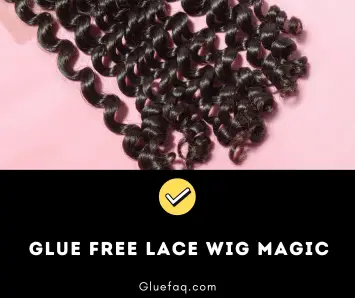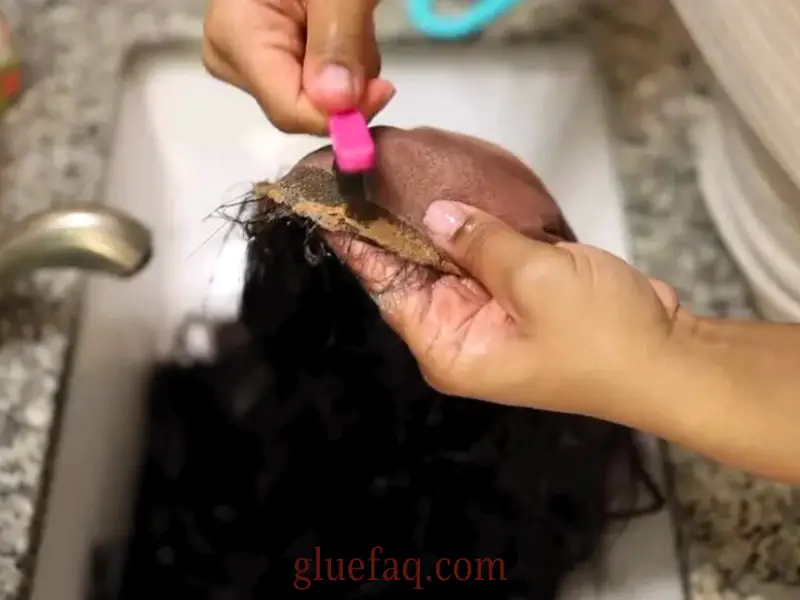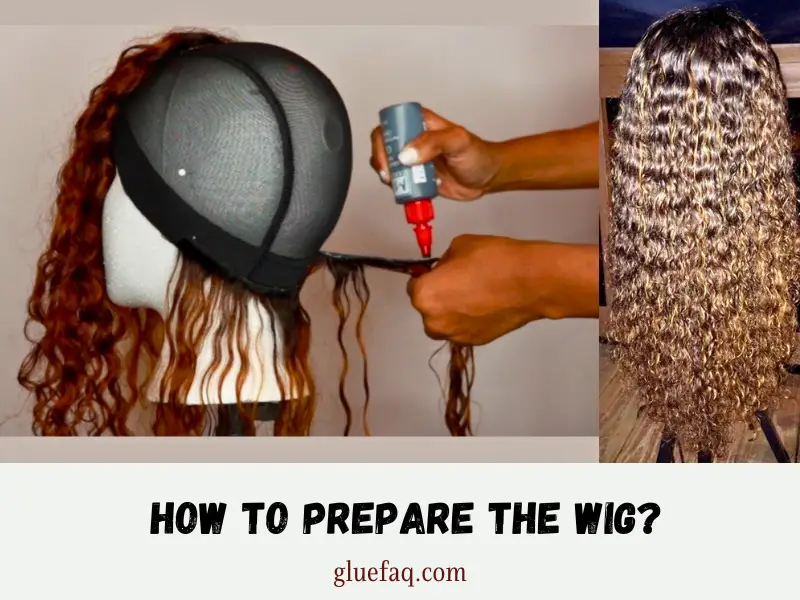Glue-Free Lace Wig: Free Lace Wigs are a fantastic way to transform your look easily, but dealing with stubborn glue residue can be a major headache.

Many traditional methods involve alcohol-based solutions that can strip the wig’s natural beauty and irritate your scalp. Fear not! This article will guide you through a glue-free approach to removing adhesive residue from your lace wig, ensuring its longevity and keeping your scalp happy.
Glue Free Lace Wig Magic Approach
The revolutionary magic of the Glue-Free Lace Wig approach, a game-changer in the world of wig application, offers hassle-free styling and a natural look without any adhesive mess.

Benefits of removing glue without alcohol
- Protecting the integrity of the wig: By avoiding alcohol-based solutions, you prevent the risk of drying out the hair and lace, preserving its strength and beauty.
- Minimizing scalp irritation: Alcohol can be harsh on sensitive scalps, causing dryness, itching, and discomfort. Our glue-free techniques ensure a gentle and soothing experience.
- Preserving the natural shine and texture: Alcohol can strip away the hair’s natural luster and make it look dull. Our methods maintain the wig’s natural sheen and texture, keeping it looking vibrant and fabulous.
Necessary supplies
To embark on this glue-free journey, gather the following supplies:
- Gentle adhesive remover: Look for alcohol-free options specifically designed for wig adhesive removal.
- Fine-toothed comb: An essential tool for detangling and removing any residual glue.
- Soft microfiber cloth: Perfect for applying the adhesive remover and gently wiping away residue.
- Mild shampoo and conditioner: Ensure you have a gentle cleansing and conditioning system to keep your wig looking its best.
How to Prepare the Free Lace Wig?
The art of wig prepping like a pro: our step-by-step guide will take you through the essential techniques, including steaming for revitalized bounce, styling for effortless glamour, and storing for long-lasting beauty.

Removing excess glue
- Gently detangling the hair: Use a fine-toothed comb to remove any tangles and knots from the wig carefully. Be patient and gentle to avoid damaging the hair strands.
- Using a comb to scrape off residual glue: Take your comb and gently scrape off any visible glue residue from the lace and hairline. Proceed with caution to avoid damaging the delicate lace.
- Treating stubborn spots with adhesive remover: If there are stubborn spots where glue persists, lightly apply a small amount of your chosen adhesive remover onto a soft microfiber cloth and gently dab the affected area. Allow the remover to penetrate the glue for a few minutes before proceeding.
Protecting the lace
- Applying a protective barrier: Before applying the adhesive remover, safeguard the lace by using a protective barrier. This can be achieved by applying a thin layer of petroleum jelly or a wig-friendly oil along the hairline, creating a barrier between the remover and the lace.
- Using a cotton pad to cover the lace: Place a cotton pad over it, ensuring it covers the areas with adhesive residue. This protective layer prevents the adhesive remover from saturating the lace and potentially causing damage.
- Securing the cotton pad in place: Gently press the cotton pad onto the lace, securing it in place. Take care not to displace the pad while performing the glue removal process.
Applying the Adhesive Remover
Choosing the right adhesive remover
- Alcohol-free options are available: Opt for adhesive removers specifically formulated to be alcohol-free. This ensures the safest and gentlest removal process for your lace wig.
- Considering the type of adhesive used: Different adhesives may require specific removers. Check the instructions on your adhesive remover to ensure compatibility with the adhesive used for your lace wig.
Step-by-step process
- Applying a small amount of remover onto a cloth: Pour a small amount of the adhesive remover onto a soft microfiber cloth. Remember, a little goes a long way.
- Dabbing the cloth onto the adhesive residue: Gently dab the cloth onto the areas with adhesive residue, focusing on the spots where the glue is the most stubborn. Apply light pressure and let the remover work its magic.
- Gently massage the area to loosen the glue: Using circular motions, softly massage the adhesive remover into the residue. This helps break down the glue and allows it to separate from the lace and hair strands. Be patient and avoid aggressive rubbing.
- Repeating the process for stubborn areas: For areas where the glue is particularly stubborn, you may need to repeat the application of the adhesive remover. Apply a fresh coat of remover to the cloth and gently dab and massage the area again until the residue loosens.
Read: Adhesive Remover
Removing the Residue of Lace Wig
Gentle Combing technique
- Starting from the ends and working upward: Begin by combing the hair from the ends, gradually working your way up towards the roots. This helps prevent unnecessary pulling and minimizes potential damage to the wig.
- Using a fine-toothed comb to separate the strands: Take your fine-toothed comb and carefully comb through the hair, focusing on sections with residual glue. Work in small, gentle strokes, ensuring the comb passes through smoothly without any resistance.
- Gradually working through the entire wig: Continue combing through the wig, section by section, until you have covered the entire surface. Be thorough but gentle, taking your time to remove any remaining residue.
Washing and Conditioning
- Rinsing the wig with lukewarm water: Once the adhesive residue has been removed, rinse the wig under lukewarm water. Ensure that the water flows in the same direction as the hair to prevent tangling.
- Applying a mild shampoo to cleanse: Gently lather a mild shampoo onto the wig, focusing on the hair strands. Use your fingertips to massage the shampoo through the hair, being careful not to tangle or twist the strands.
- Conditioning to restore softness and manageability: Rinse out the shampoo and apply a wig-friendly conditioner. Spread the conditioner evenly throughout the hair, focusing on the ends. Allow it to sit for a few minutes to restore moisture and softness.
- Air-drying the wig for best results: After rinsing out the conditioner, gently squeeze out excess water and place the wig on a wig stand or a clean, dry towel. Allow it to air dry completely before styling or wearing it again. Avoid using heat-styling tools on wet or damp wigs.
Glue Free Lace Wig Finishing Touches
Styling the wig
- Using a wig stand for stability: Place the wig on a wig stand to maintain its shape and prevent tangling during styling. This also allows air to circulate and promotes faster drying.
- Brushing or combing to desired style: Once the wig is dry, use a wide-toothed comb or a wig brush to style it according to your preference. Start from the ends and work your way up, gently detangling any knots or tangles that may have formed during the drying process.
- Applying wig-friendly styling products: If desired, apply wig-friendly styling products such as a wig spray or serum to enhance shine, control frizz, or add volume. Be sure to choose products specifically designed for synthetic or human hair wigs.
Final inspection
- Checking for any remaining residue: Take a close look at the wig under good lighting to ensure that all adhesive residue has been completely removed. Use your fingertips to feel for any sticky areas or bumps that may indicate leftover glue.
- Repeating the process if necessary: If you notice any remaining residue, repeat the glue-free removal process, focusing on the specific areas that still have glue. Patience and thoroughness are key to achieving a flawless result.
FAQs About Glue Free Lace Wig
No, it is not recommended to use alcohol-based removers on a lace wig as they can strip away the wig’s natural beauty and cause scalp irritation.
The frequency of removing adhesive residue depends on how often you wear the wig and the type of adhesive used. It is generally recommended to remove residue after each use or when it becomes noticeable.
If you accidentally damage the lace while removing glue, it is best to consult with a professional wig stylist or lace wig provider for repairs or guidance on lace repair kits.
Yes, there are alternative methods such as using adhesive removers specifically designed for lace wigs, natural oil-based solvents, or homemade solutions using gentle ingredients like baby oil or coconut oil. However, it’s important to research and ensure the safety and effectiveness of these alternatives before using them on your wig.
Yes, once the adhesive residue is removed, you can reuse the wig as desired. Remember to properly care for and store the wig to maintain its quality and longevity.
Conclusion
By following these guidelines, you can confidently remove adhesive residue from your lace wig without alcohol, preserving its beauty and ensuring a comfortable and stylish experience.
